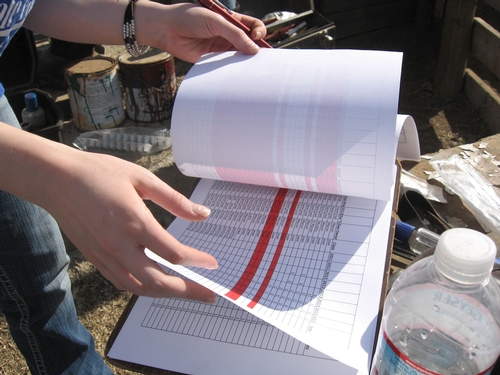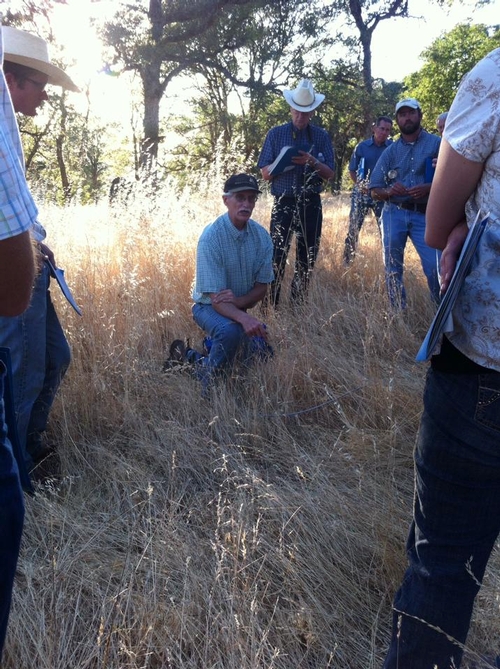Posts Tagged: ranching
The Biology of Farm Size – Or How I Learned to Doubt my Spreadsheets
I'm a spreadsheet guy – I love plugging numbers and formulas into Excel and getting answers! I use spreadsheets to analyze the economics of my business, to predict the amount of pasture grass available for my sheep, and to keep track of orders for my lamb. As a planning tool, spreadsheets can be enormously helpful – but they can also be dangerously seductive. For example, by simply tweaking a single number (like expected lambing percentage), I can turn a projected unprofitable year into a profitable one!
As I continue to think about the question of scale in sustainable farming and ranching, however, I've begun to see the danger in relying on spreadsheets alone. Spreadsheets can tempt us to omit biology from the equation. Let me explain:
There is an upper limit to what an acre of even the most fertile farmland will produce. Based on the yield estimates supplied by Johnny's Seeds, an acre of sweet corn will produce 14,400 ears of corn. Even charging $1/ear, an acre of sweet corn, obviously, won't support a full-time income for the farmer (which is why most local farmers grow more profitable crops). So let's look at a “sexier” (at least according to food writers) crop like kale! An acre of kale will produce 16,275 pounds of harvested product – that's a lot of kale smoothies! My colleague Jim Muck reports that he charges $2 for a half-pound bundle of kale. At that price, an acre field of kale would generate $65,100 in gross revenue – not bad, right?! But wait – aren't there costs associated with growing that acre of kale? Certainly the farmer must put in considerable labor – which has a cost to it. Then there's water, fertilizer, seed, supplies, fuel, marketing costs, storage costs, insurance, land rent (or a mortgage) – that $65,100 in revenue might be offset by as much as $50,000 to 60,000 in direct and overhead costs. In my world, $5,000 to $15,000 isn't enough income to support my family for a year. In other words, the biological limits of my acre of farmland suggest that I need to operate at a larger scale if I want to make a living.
Perhaps livestock operations are different – let's take a look! In our part of the Sierra foothills, an acre of unirrigated rangeland pasture will, on average, grow enough grass to support five mature ewes for one month (these five ewes will need 12 acres of rangeland to get through the whole year). One acre of irrigated pasture will support my five ewes for six months. If I do everything right in caring for my ewes, these five sheep will give birth to 8-10 lambs. If I finish these lambs and sell them as meat at the farmers market, I'll gross $2,400 to $3,000 – all from my acre of land! Just like my friend the vegetable farmer, however, I'll have expenses – things like processing charges, transportation, insurance, land rent, water, veterinary costs, and supplemental feed costs. My net income – which pays my “salary” – is $300-500 from these 8-10 lambs. Once again, biology suggests that I need to operate at a larger scale.
Spreadsheets make it dangerously easy to manipulate these numbers and projections. If I can boost my projected yield of kale by just five percent, it makes my bottom line look much more attractive! Unfortunately, these biological limits don't allow us to fudge our numbers that much. Size, as it turns out, does matter (at least economically).
Don't get me wrong – I'm not advocating for huge monoculture farms. I do think, however, that the romantic notion of micro-farming (less than 2 acres) – the darling of our local food movement – is not the answer, either. If Auburn (for example) needs 25 pounds of kale per person to satisfy local demand for kale, the community would need to grow just over 22 acres of kale. Would 22 1-acre kale farms (none of which would be paying its owner a living wage) be more sustainable, or would it be better to have one or two kale farms that paid the farmer a reasonable annual salary? In other words, do we want a local food system that requires farmers to subsidize their farms with outside income and/or unpaid labor, or do we want a system that is economically viable for consumer and farmer alike? I worry that we may be creating a farming system that requires its farmers to have another source of income (like an off farm job or a retirement fund) in order to keep farming – such a system means we won't likely see young families able to start farms that will be viable over the long term.
I still use spreadsheets in my ongoing attempts to look at the economics of my business, but I've realized that the allure of adjusting the numbers until the farm looks profitable is dangerous (at least for me). My future spreadsheets will begin with the parameters set by the productivity of my land – there is an upper limit to what my soil can produce. My projections must be anchored in reality – and informed by my experience and the experiences of my fellow farmers and ranchers. My spreadsheets must take biology into account!
What Drought!? Perceptions and Reality about Water in the Sierra Foothills
Last Tuesday morning, my job with UC Cooperative Extension took me to the Roseville Farmers' Market at the Fountains Shopping Center. As I was leaving the market, I drove past the water fountains for which the center is named – and found them running! While I'm not sure whether these water features use recycled water (I sure hope they do), they symbolize our collective lack of awareness – and lack of concern – regarding California's drought.
When our “water year” ends on June 30, we will have received somewhere around half of our normal precipitation – other parts of California have fared far worse. Those of us who have rangeland livestock operations have been feeling the effects of this lack of precipitation since last fall. If you'll remember, we had a good rain on Labor Day last year, followed by dry weather for the rest of September and much of October. The grass that germinated with the Labor Day rain didn't survive. We had our next germinating rain in November, followed by a cold spell. After we measured a half-inch of snow in early December, we were dry for a record-setting 50+ days. While we had more than 8” of rain over the course of 4 days in early February, the grass on our rangelands really didn't grow until March. I'm sure the abnormally dry winter also impacted many orchards and vineyards as well – impacts that some growers are just starting to see now.
The lack of snowpack this year was even more severe. In our region of the Sierra, the May 1 snowpack was just 22 percent of normal. As of June 9, our snowpack had disappeared – the Department of Water Resources (DWR) reports that our snowpack is 0 percent of normal for that date (as a comparison, during a pack trip south of Sonora Pass in August of 1996, I rode through 3-4 foot snowdrifts). Our summer irrigation water – whether we're customers of the Nevada Irrigation District (NID) or Placer County Water Agency (PCWA) – depends on our ability to store water in the form of snow. The reservoirs that NID and PCWA operate don't have enough capacity to store all of our water needs without some of this water coming into the system as late-season snowmelt. Based on the DWR numbers, our snowmelt has ended for this water year.
While most of us think of drought as a weather phenomenon, droughts can be created through law and regulation as well. Back in January, Governor Jerry Brown declared a drought emergency. In his declaration, the Governor indicated that curtailment of water diversions might be necessary to preserve water supplies. In late May, the State Water Resources Control Board (which regulates surface water rights) sent letters to all of the “junior” water rights holders in the Sacramento River watershed ordering them to stop diverting water immediately. Locally, this meant that NID has to allow any water flowing into its reservoirs from these junior (or post-1914) water rights to pass through – in other words, if a stream subject to a junior water right is flowing at 10 cubic feet per second into one of NID's reservoirs, the district has to release 10 cfs at the damn. This water can't be stored for future use! To complicate matters further, this curtailment order remains in place for 270 days unless it's lifted (and no one is certain of the process for lifting it). This means that NID might not be able to store any water from these junior water rights until the end of February 2015 – well into next year's rainy season. This uncertainty makes me nervous – what happens if we have a warm winter and more of our mountain precipitation falls as rain? With this order in place, we couldn't store it for next summer's irrigation season.
Back to Tuesday - that evening, I attended a drought meeting organized by the Placer County Farm Bureau. NID and PCWA provided an update on water conservation efforts and prospects for the rest of this irrigation season. Both agencies reported that they thought they'd be able to provide full water deliveries to most customers for the full irrigation season (through October 15). Both agencies also expressed hope for a return to normal precipitation next fall and winter, while conceding that another dry year (or continued curtailment of water rights) could pose challenges for the 2015 irrigation season.
I was astonished by the low turnout at the meeting – only 15-20 commercial farmers and ranchers attended. A number of folks, like me, had livestock operations. Others grew mandarins or other permanent crops, and one or two grew vegetables.
All of us – myself included – take water for granted, I think. Once NID and PCWA announced this spring that they'd be able to make full water deliveries, many of us put our worries about the drought on a back burner. Water continued to flow; we moved on to other worries. For many of my vegetable-grower friends, the mild and dry spring was actually a benefit – they were able to work ground and plant much earlier than normal, which allowed them to bring crops to market sooner than normal.
As for me, I can't shake the idea that we're not out of the woods yet. I think back to what our rangelands looked like in January and February, and I'm frightened by the prospects of another dry fall and winter. I found a great quote on the California Water Blog (written by UC Davis professors Jeffrey Mount and Jay Lund) – “Hope is not a strategy.” While I certainly hope that we have a wet winter ahead of us, I continue to work on my drought strategy. In other words, I'm hoping for the best but preparing for the worst.
What does this look like for your operation? I find myself looking ahead to the quality and quantity of forage that I can take our sheep to in September and October – and looking even further ahead to December and January. If it doesn't rain this fall, I'm stockpiling dry grass pastures to graze during the winter months. We've also identified small irrigated pastures that will allow us to prepare our ewes for our fall breeding season – rather than finishing lambs on these pastures this summer, we're saving them for the ewes with the hope that we can increasing next year's lambing percentage. We're also looking at opportunities for improving our irrigation technology – more efficient sprinklers and soil moisture monitoring. I'm going to start looking into options for planting forages that are more drought tolerant than our typical irrigated pasture grasses. Finally, I'm starting to think about ways that I can take advantage of good rainfall years – both economically and ecologically. Perhaps I'll buy feeder lambs in years when we have strong forage growth – perhaps there are other options as well.
Several weeks ago, I was talking to a neighbor at one of the ranches we lease. I told her about some of the things we'd had to do to cope with the dry winter and spring. Commiserating, she told me that her kids were terribly disappointed that the sprinkler park in Rocklin had been closed because of the drought. While I realize that she told the story out of sympathy, I was struck how insulated most non-farmers are from this drought – the Fountains in Roseville are another example. Tuesday night's meeting reminded me that farmers and ranchers aren't immune from complacency.
Here are some links to resources and information about the drought:
- Farmer-Rancher Drought Forum (Facebook)
- Farmer and Rancher Voices from the Drought (Facebook)
- Foothill Farming Drought Resources Page
- U.S. Drought Monitor
- Nevada Irrigation District Drought Information
- Placer County Water Agency Drought Information
- UC Davis Drought Page
- California Irrigation Management Information System




